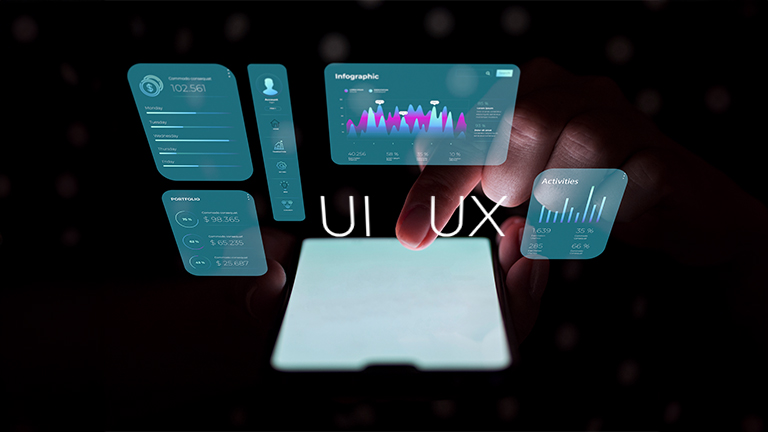Technologies that shape how we consume digital experiences are ever changing. So do short-term fads and maybe even long-term trends. However, the fundamentals of how humans interact with digital experiences have not changed and will not change for eons.
At Robosoft, we believe consumers prefer experiences that strike an emotional chord – especially those which make them feel positive & productive as they effortlessly complete whatever task they set out to do in the digital world. We believe this fundamental truth will still hold good for 2025 and beyond. UI UX teams play a crucial role in understanding and adapting to new developments which can help them ‘engineer’ a better digital experience. Let us look at a few such trends that are likely to make an impact in experience design and how we must adapt.
Key UI UX trends impacting experience design
Let’s explore select UI UX design trends set to redefine digital experiences in 2025:
- Micro-interactions with haptic feedback: small animations or tactile responses on hover or click provide instant feedback to users, making the interface more interactive and satisfying.
- Voice-activated interfaces and conversational UI: voice commands and chat-driven interfaces will improve accessibility and provide hands-free solutions, catering to users on the go or those with disabilities.
- Design for augmented and virtual reality experiences: these offer huge scope to enhance user engagement in apps related to shopping, gaming, education, and healthcare.
- AI-powered personalization: tailored experiences based on user behavior, preferences, usage habits, and patterns, by leveraging AI and Machine Learning. This includes dynamic content recommendations and predictive interfaces. For example, Spotify can analyze much larger volumes of data beyond user listening history. It can also evaluate contextual factors such as time of day, location, what device is being used, and even what mood the user is in. Such personalization helps in crafting smarter, context-aware experiences. AI-powered personalization will also empower designers to craft experiences that not only meet users’ functional needs but also align with their emotional preferences, creating deeper and more meaningful connections.
- Effortless efficiency with minimalist UI design: traditionally, the financial sector has witnessed clunky, cluttered design. But banking and productivity apps will increasingly adopt clean, easy-to-navigate UIs. This segment will also witness minimalistic designs with soft gradients to create a visually pleasing, intuitive UI while reducing cognitive load.
- Super apps will redefine convenience with all-in-one experiences: apps are evolving into multi-functional platforms where users can access various services (e.g., messaging, shopping, payments) without switching apps, creating convenience and seamless navigation.
- Accessibility-friendly apps: with scalable font sizes and minimalistic designs will see increasing adoption. Dark mode will become more adaptive, adjusting based on ambient light and reducing eye strain during prolonged app usage.
How can product, design, and engineering teams collaborate better amidst these developments?
- Product UX UI must explore generative AI tools and platforms to help create pilot projects across different industry verticals and apps and larger solution.
- Software engineering leaders must leverage design systems that promote reuse and assembly to build digital products with effective UX designs quickly,
- User experience (UX UI ) professionals with strong creative thinking, behavioral science, design strategy, and prompt design skills will be in high demand, as generative AI automates lower-order tasks such as wire-framing, screen design, and basic copywriting
- For UX UI designers, the emergence of distinct interaction patterns and principles for designing AI-assisted experiences.
AI-centric use cases for designers to explore
Designers can explore these innovative use cases to prototype solutions that leverage conversational interfaces, personalization, and accessibility.
- Design and develop AI-driven applications with conversational or visual elements.
- A shopping app that personalizes product categories, offers, and navigation based on each user’s shopping habits.
- Customer service chatbot for a pilot project.
- Healthcare app chatbot that guides users to find the right doctor, schedule appointments, and track medical history.
- Banking or Airline app that uses voice-controlled navigation and screen magnification for visually impaired users.
Designers can further explore these as research areas:
- Design tools and plugins to generate lo-fi UX wireframes/flows and imagery graphics based on brief user inputs (e.g., industry type, key features).
- Use AI to analyze user feedback (reviews, surveys, app ratings) to prioritize UX UI improvements.
Conclusion
The real value of UX designers is not just in creating great wireframes and UI but also in solving problems, thinking strategically with the product-strategy team, and having a big-picture vision to create the design experience.
As UI UX design trends continue to evolve, staying ahead of these innovations will be crucial for shaping both the physical and digital experiences. While the tools, technologies, and trends evolve, the core principle remains unchanged: delivering intuitive, meaningful, and emotionally led design experiences that empower users.
By embracing advanced tech such as AI-driven personalization, immersive design interfaces, and super apps, design teams can explore newer opportunities to enhance user engagement and increase retention. The future of UX UI resides in the ability to adapt, innovate, and empathize with the end-user needs while leveraging emerging technologies to create experiences that are not just functional but truly memorable.
Connect with us to craft engaging digital experiences that build customer loyalty.






